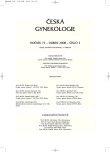-
Medical journals
- Career
Vascular Complications of Laparoscopic Operations in Gynaecology
Authors: P. Chaloupka; Z. Rokyta; Z. Novotný; V. Kališ
Authors‘ workplace: Gynekologicko-porodnická klinika LF UK a FN, Plzeň, přednosta doc. MUDr. Z. Rokyta, CSc.
Published in: Ceska Gynekol 2008; 73(2): 102-104
Overview
Objective:
To provide information about vascular complications of laparoscopic operations in gynaecology.Type of study:
Literature review and case reports.Setting:
Department of Gynaecology and Obstetrics, Medical faculty, Charles University, Pilsen.Methods:
Review of literature concerning vascular complications during laparoscopic operations in gynecology and case reports to illustrate the topic.Conclusion:
Laparoscopic operations are benefiting for patiens. Vascular complications are rare, but their progression is often fatal even for young patients. When such complications occur, their quick treatment is crucial and co-operation with a anaesthesiologist and vascular surgeon is needed.Key words:
aorta, vena cava inferior, pelvic vessels, epigastric vessels, hemorrhage, shock
Sources
1. Barros, BM., Lozano, SF., Queral, L.Vascular injuries during gynecological laparoscopy—the vascular surgeon’s advice. Sao Paulo Med J, 2005, 123, 1, p. 38-41.
2. Bhoyrul, S., Vierra, MA., Nezhat, CR., et al. Trocar injuries in laparoscopic surgery. J Am Coll Surg, 2001,192, 6, p. 677-683.
3. Dixon, M., Carrillo, EH. Iliac vascular injuries during elective laparoscopic surgery. Surg Endosc, 1999, 13, 12, p. 1230-1233.
4. Garry, R. Towards evidence-based laparoscopic entry techniques: Clinical problems and dilemmas. Gynaec Endosc, 1999, 8, p. 315-326.
5. Holub, Z. Klinické problémy a komplikace laparoskopického vstupu. Čes Gynek, 2000, 65, s. 464-470.
6. Hurd, WW., Amesse, LS., Gruber, JS., et al. Visualization of the epigastric vessels and bladder before laparoscopic trokar placement. Fertil Steril, 2003, 80, 1, p. 209-212.
7. Nezhat, F., Mahdavi, A., Nagarsheth, NP. Total laparoscopic radical hysterectomy and pelvic lymphadenectomy using harmonic shears. Minim Invasive Gynecol, 2006, 13, 1, p. 20-25.
8. Novotný, Z., Smitková, V. Národní registr komplikací gynekologické endoskopie.
9. Polyzos, D., Papadopoulos, N., Chapman, L., et al. Where is the aorta? Is it worth palpating the aorta prior to laparoscopy? Acta Obstet Gynecol Scand, 2007, 86, 2, p. 235-239.
10. Possover, M., Krause, N., Plaul, K., et al. Laparoscopic para-aortic and pelvic lymphadenectomy: experience with 150 patients and review of the literature. Gynecol Oncol, 1998, 71, 1, p. 19-28.
11. Ridel, NH., Lehman-Willenbrock, E., Semm, K. German pelviscopic statistics for the years 1978-1982. Endoscopy, 1986, 18, p. 219-222.
12. Saber, AA., Meslemani, AM., Davis, R., Pimentel, R. Safety zones for anterior abdominal wall entry during laparoscopy: a CT scan mapping of epigastric vessels. Ann Surg, 2004, 239, 2, p. 182-185.
13. Schäfer, M., Lauper, M., Krähenbühl, L. Trocar and Veress needle injuries during laparoscopy. Surg Endosc, 2001. 15, 3, p. 275-280.
14. Scribner, DR. Jr., Walker, JL., Johnson, GA., et al. Laparoscopic pelvic and paraaortic lymph node dissection: analysis of the first 100 cases. Gynecol Oncol, 2001, 82, 3, p. 498-503.
Labels
Paediatric gynaecology Gynaecology and obstetrics Reproduction medicine
Article was published inCzech Gynaecology

2008 Issue 2-
All articles in this issue
- Stillbirth in the Czech RepublicII. Analysis of relationship of selected data
- Persistent Trophoblastic Disease in Trophoblastic Disease Center in the Czech Republic in 1955 – 2007
- Importance of Chromosomal Changes Correlated to Prognostic Factors in Ovarian and Cervical Malignant Tumors
- The Significance of Methylation in HPV16 Genome to Cervix Cancerogenesis
- Mono-follicular Development – the Objective of Ovulation Induction with Follitropin beta Combined with Intrauterine Insemination
- Levels of Prostaglandin E2 (PGE2) in Cervical Ovulatory Mucus in Women with Spontaneous Miscarriages
- Vascular Complications of Laparoscopic Operations in Gynaecology
- The Importace of Sonography and Hysteroscopy at Suspected Findings on Endometrium of Menopausal Women
- The Influence of Inflammatory Bowel Disease on the Period of Conceiving
- Caesarean Section and Anal Incontinence
- Abortion Induction in IInd trimester
- Adrenocortical Disorders in Pregnancy
- The Endometriosis Combined Treatment Results of the Department of Gynecology and Minimally Invasive Therapy, Na Homolce Hospital, Prague in six years period 2001 - 2007
- Czech Gynaecology
- Journal archive
- Current issue
- Online only
- About the journal
Most read in this issue- Abortion Induction in IInd trimester
- Persistent Trophoblastic Disease in Trophoblastic Disease Center in the Czech Republic in 1955 – 2007
- The Importace of Sonography and Hysteroscopy at Suspected Findings on Endometrium of Menopausal Women
- Adrenocortical Disorders in Pregnancy
Login#ADS_BOTTOM_SCRIPTS#Forgotten passwordEnter the email address that you registered with. We will send you instructions on how to set a new password.
- Career

